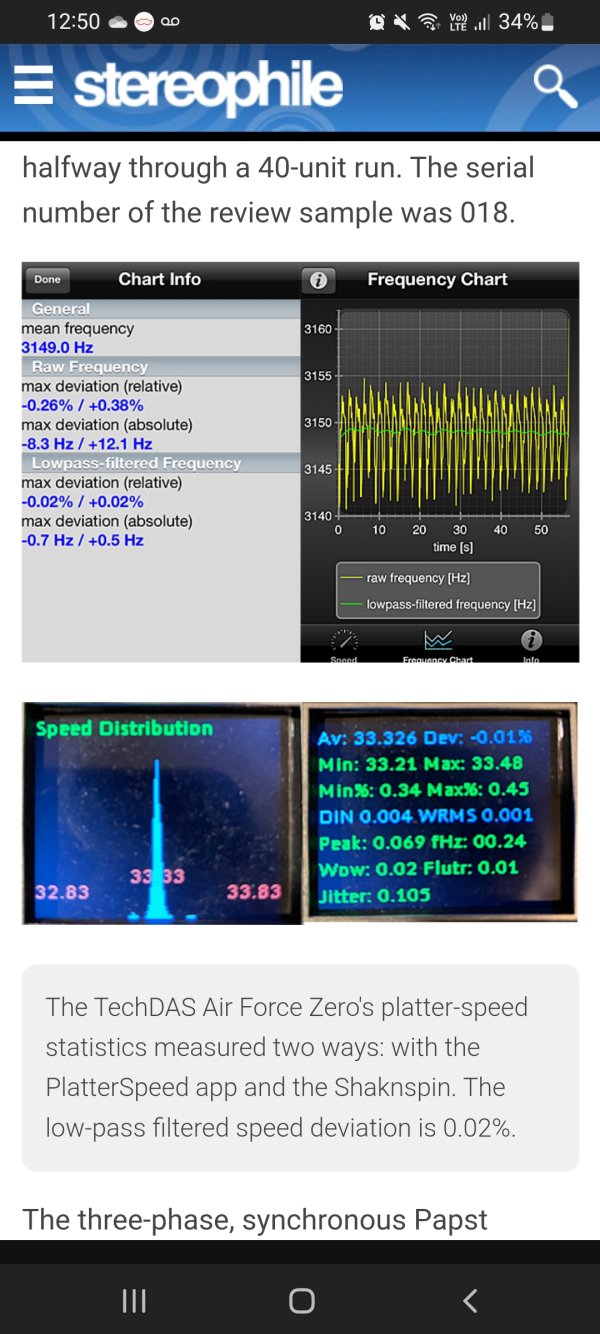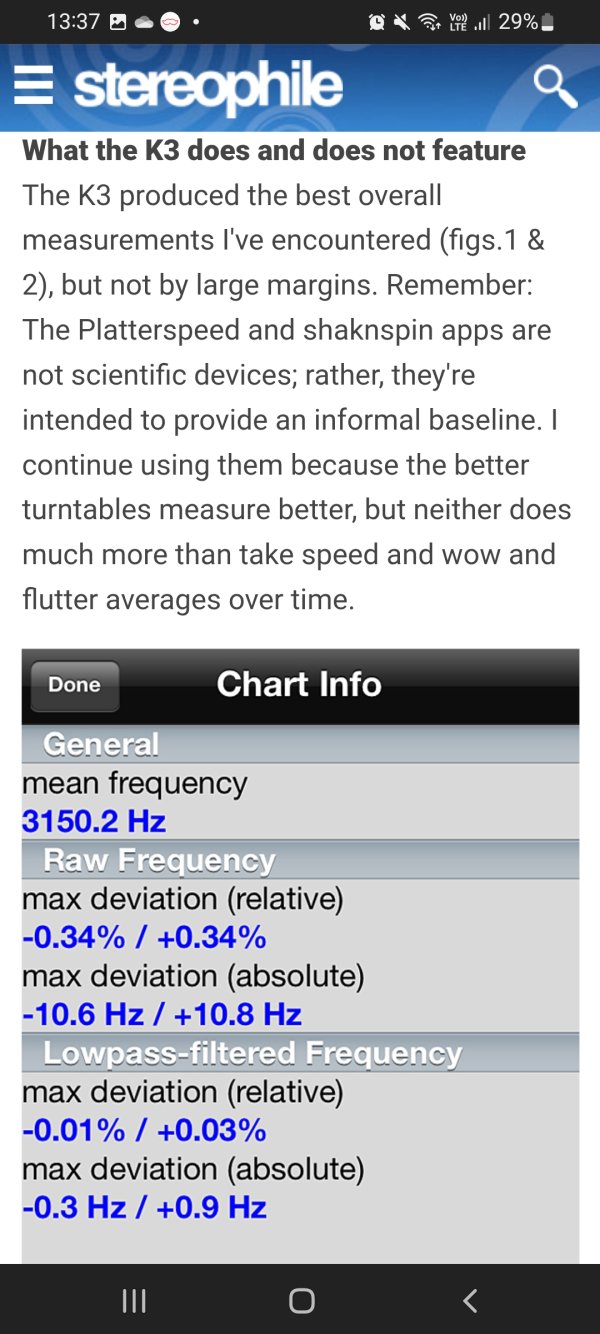It measures once every revolution, unless you are sugesting it both speeds up and slows down inside this revolution , it is pretty precise.That number every 1-2 seconds is the speed average measured over a period of time. Not the actual minimum-maximum speed.
Natural Sound
- Thread starter PeterA
- Start date
You are using an out of date browser. It may not display this or other websites correctly.
You should upgrade or use an alternative browser.
You should upgrade or use an alternative browser.
That's what i'm saying. It's showing an average speed number over a period of time. Not the actual minimum and maximum speed recorded over that period of time. Not dissing the AS at all. The motor controller is probably superb. But I don't think the roadrunner is actually measuring minimum and maximum speed. Coming back to the begining of the conversation, you said the Thorens is no match for the AS in terms of speed variation but we are using 2 totally diferent measuring devices. The phone app does show those numbers.
Most turntables will not match the performance of Peters AS 2000 when it comes to speed stability, try it out with your Forsell, or did you sell that too ?
You really need better informers ...
I agree that speed can fluctuate and still produce great sound, the micro variations of motor pulses and speed hunting on feedback systems have a larger effect on sound quality. The Papst motor in your A80 Studer is a 24 pole motor they sound very good. In comparison the AS 2000 motor has "only" 12 poles, but is synchronous and locks to the main frequency with great stability.
All synchronous motors lock to the main frequency with the same "stability" ... It is why they are called synchronous. The number of poles determines the angular speed. IMO the high stability of the AS 2000 is mainly due to the flywheel - a wise addition. Studer motors have an outer rotor, that works as a flywheel - surely not as well balanced as the precision one of the AS2000 or AirTech zero.
We should not tell the non-feedback crowd that curiously in the A80 machines, Studer do not operate the capstan motor in synchronous mode, they rely on a tachometer with feedback. These people would probably banish everything having been recorded or processed in a A80.
Most of our discussions on motor systems is due to poor semantics. If people simply addressed accuracy and precision correctly, the efficiency of discussion would increase significantly. Speed stability is good for car magazines, not for turntable accession.
No the limitations of the phone app are probably bigger than those of the Roadrunner, you will be surprised of the helpfulness of being able to monitor speed real time with the needle in the groove. Also very helpful when you are dialing in a motor position or belt placement , a little of on the pulley can give a lot of speed variations.That's what i'm saying. It's showing an average speed number over a period of time. Not the actual minimum and maximum speed recorded over that period of time. Not dissing the AS at all. The motor controller is probably superb. But I don't think the roadrunner is actually measuring minimum and maximum speed. Coming back to the begining of the conversation, you said the Thorens is no match for the AS in terms of speed variation but we are using 2 totally diferent measuring devices. The phone app does show those numbers.
How are you confirming who is the expert to advise you? By your own judgement of “expert”?
Surely.
For example Peter and Tima consider David as expert.
Lagonda might be considering Marc.
Yes, Each of us has his own requirements.
Does your expert have a system or videos we can all learn from
Fortunately no videos of these people. Mainly documented reports and well founded opinions. Surely we do not agree all the time.
Yes if you cannot hear the difference it does not matter much, but motor torque, pole numbers and flywheels, internal or external, make a big difference in sound. Heard with my own ears on my own turntable, not read in a textbook. You will probably come to the same conclusions once you start experimenting.You really need better informers ...
All synchronous motors lock to the main frequency with the same "stability" ... It is why they are called synchronous. The number of poles determines the angular speed. IMO the high stability of the AS 2000 is mainly due to the flywheel - a wise addition. Studer motors have an outer rotor, that works as a flywheel - surely not as well balanced as the precision one of the AS2000 or AirTech zero.
We should not tell the non-feedback crowd that curiously in the A80 machines, Studer do not operate the capstan motor in synchronous mode, they rely on a tachometer with feedback. These people would probably banish everything having been recorded or processed in a A80.
Most of our discussions on motor systems is due to poor semantics. If people simply addressed accuracy and precision correctly, the efficiency of discussion would increase significantly. Speed stability is good for car magazines, not for turntable accession.
That number every 1-2 seconds is the speed average measured over a period of time. Not the actual minimum-maximum speed.
Yes, the white paper of Grand Prix Audio turntables addressed this aspect in great detail - it is why they measure the speed around 16000 times per revolution - I thing I am not being wrong, I have not checked the exact number. Technical brochures of old DD japanese turntables also addressed it.
I'm measuring the speed in real time while the needle is on the record, reason why I said "under dynamic load". You just place the phone over the TT weight.No the limitations of the phone app are probably bigger than those of the Roadrunner, you will be surprised of the helpfulness of being able to monitor speed real time with the needle in the groove. Also very helpful when you are dialing in a motor position or belt placement , a little of on the pulley can give a lot of speed variations.
I stand by what I said. The roadrunner does not measure minimum and maximum speed (cogging). It only gives an average speed.
Yes if you cannot hear the difference it does not matter much, but motor torque, pole numbers and flywheels, internal or external, make a big difference in sound.
Heard with my own ears on my own turntable, not read in a textbook.
In this subjective hobby everything makes a difference - it is the essence of the high-end - and our ears are supposed to be judge. So everything you wrote is true and above discussion., but nothing really new ...
You will probably come to the same conclusions once you start experimenting.
Surely. But I will experiment with what I think are the objectively best options at my reach, supported by proper tools, not audio gadgets .
An average speed over one revolution is the measurement. Pretty precise !I'm measuring the speed in real time while the needle is on the record, reason why I said "under dynamic load". You just place the phone over the TT weight.
I stand by what I said. The roadrunner does not measure minimum and maximum speed (cogging). It only gives an average speed.
You have talked about doing this about 5 years now Fransisco, time to put on your work gloves fire up your scopes and get going.In this subjective hobby everything makes a difference - it is the essence of the high-end - and our ears are supposed to be judge. So everything you wrote is true and above discussion., but nothing really new ...
Surely. But I will experiment with what I think are the objectively best options at my reach, supported by proper tools, not audio gadgets .
What I don’t quite understand is that you are doing this research to presumably guide you when choosing your new turntable. Don’t you think the results of the test you propose are going to vary depending on the design of the turntable? With the motor detached, you are looking at the bearing friction and platter mass, but also the proportions of the platter will likely matter. And some turntables might even even stop spinning before the five minute test is over. I would think the effect of stylist drag will vary, depending on the design of the turntable.
Why don’t you do the test yourself on the turntables you’re considering buying. My turntable is no longer available and so information you glean from that won’t really be relevant.
Anyway thanks, Peter.
In fact the information we can extract from the two beltless videos you kindly published is extremely relevant for any one wanting to better understand your turntable and air bearing designs.
I am not a turntable designer or a manufacturer, this information will mainly satisfy my technical curiosity and will of knowledge - and surely propitiate interesting debates with people with similar interests.
You have talked about doing this about 5 years now Fransisco, time to put on your work gloves fire up your scopes and get going.
Other projects, such as the A80's refurbishment, electrostatic speakers and rebuilding a house kept me busy.
You are always the professor of theory !
Again wrong. It seems your audio internet life is limited to WBF ...
Other projects, such as the A80's refurbishment, electrostatic speakers and rebuilding a house kept me busy.
That’s good. Are you moving to quads or staying with sound labs.
But will the TT still play though Wilson and big amps with digital recordings? Or are you moving to horns too after your favourite reviewer did
Yes, I am always changing something ... For me it is part of the hobby.
Yes, I am always changing something ... For me it is part of the hobby.
You are just going back to natural sound
That’s good. Are you moving to quads or staying with sound labs.
Or Alexia's with subs. Or Trios's. Or Magico Q7 mk2 . Who knows?
Can you link us to these documented reports and opinions you consider well founded. Please don’t keep learnings to yourself. Spread the loveFortunately no videos of these people. Mainly documented reports and well founded opinions. Surely we do not agree all the time.
Similar threads
- Replies
- 56
- Views
- 4K
- Replies
- 55
- Views
- 4K
- Replies
- 1
- Views
- 1K
- Replies
- 16
- Views
- 4K
- Replies
- 12
- Views
- 3K
| Steve Williams Site Founder | Site Owner | Administrator | Ron Resnick Site Owner | Administrator | Julian (The Fixer) Website Build | Marketing Managersing |




